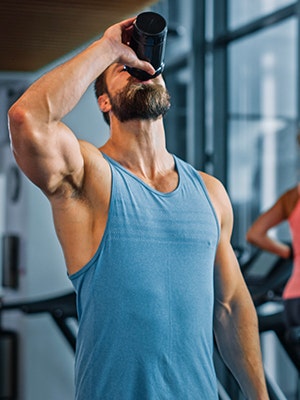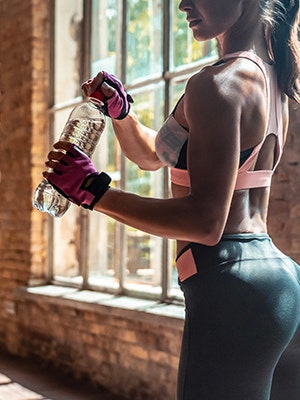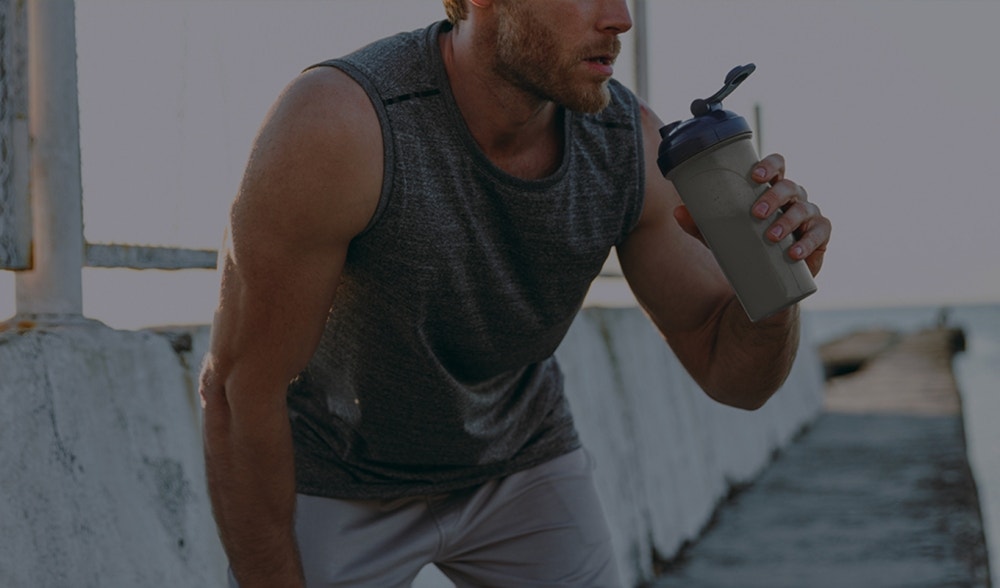 Hydration has always played an important role in sports performance, injury prevention and recovery after training sessions or competitions, both for athletes engaged in competitive sports or competitions and at an amateur level . Therefore, it is extremely important that both coaches and athletes clearly understand the mechanisms and physiology of this mechanism, in order to improve the hydration needs of sportsmen for preventive but also for lending purposes.
Hydration has always played an important role in sports performance, injury prevention and recovery after training sessions or competitions, both for athletes engaged in competitive sports or competitions and at an amateur level . Therefore, it is extremely important that both coaches and athletes clearly understand the mechanisms and physiology of this mechanism, in order to improve the hydration needs of sportsmen for preventive but also for lending purposes.
Let's start from the basics: in a sedentary subject the daily water exchange is around 2.5 liters (between entries and exits), but the liquids that actually circulate in the entire digestive system amount to approximately 9 litres. When it comes to athletes these quantities vary considerably and the demands for liquids have increased, obviously due to an increase in outings, above all in the form of sweat. These losses must be adequately compensated by an increase in revenue, in order not to risk incurring problems and repercussions (which we will discuss later).
The quantity of water to be reintegrated then varies according to individual characteristics, the intensity and quantity of muscular work and, above all, in relation to climatic conditions. It is therefore not possible to establish a priori the needs of the individual subject, which are strictly personal.
Physiology and mechanisms of the state of hydration
However, it is important to always keep in mind some physiological aspects, which allow us to better understand how the state of hydration of the individual works: body water represents approximately 60% of the total body weight in an adult man (therefore more than half of the number that we see on the scale when we weigh ourselves). The amount of intracellular water (also technically called ICW - Intra Cellular Water ) amounts to 2/3 of the total body water (66%), while the extracellular water content (which is indicated instead as ECW - Extra Cellular Water ) amounts to 1/3 of the total body water (or Total Body Water -TBW ) and represents 35%.
Broadly speaking, the water requirement of a person who performs physical activity is about 1 ml for  each calorie of energy expenditure . If physical activity exceeds 2 hours, dehydration can even reach 5% of body weight: a value far too high to be underestimated, and which can also lead to serious complications if not promptly reintegrated. This lack of liquids must therefore be adequately and promptly rebalanced; otherwise it creates the conditions for a rapid deterioration of the athlete's performance.
each calorie of energy expenditure . If physical activity exceeds 2 hours, dehydration can even reach 5% of body weight: a value far too high to be underestimated, and which can also lead to serious complications if not promptly reintegrated. This lack of liquids must therefore be adequately and promptly rebalanced; otherwise it creates the conditions for a rapid deterioration of the athlete's performance.
Respect for the choice of hypo- or isotonic solutions and the use of any targeted supplementation is necessary to avoid that a significant quantity of pure water also leads to the dilution of extracellular fluids. This could in fact determine, thanks to the action of the pituitary gland, the secretion (i.e. the production and secretion) of adiuretin, a hormone also known as "vasopressin", with consequent elimination of excess fluids, but which also entails unpleasant consequences for a athlete.
In general, the lack of liquids and consequently of salts, especially in humid and hot conditions, is signaled by symptoms such as nausea, vomiting, dizziness and general tiredness, as well as by a significant impairment of performance . If you insist on continuing to exercise despite the onset of symptoms, you may experience muscle cramps and difficulty concentrating. To correctly calculate the quantity of substances to be replenished, it is necessary to remember some concepts, linked to the definition of osmolarity, which we report below.
The term osmolarity refers to a physical quantity that measures the concentration of solutions, and its value expresses precisely the concentration of the solution under examination. Under normal conditions, the osmolarity is identical for all the fluids present in the various compartments of the organism (which can be divided into intra and extra cellular) The volume of extracellular fluid is generally estimated at 0.255 l/Kg of body weight , and the factor The main factor that regulates the distribution of body water between the extracellular (EC) and intracellular (IC) districts is the osmotic pressureof the liquids themselves. Osmotic pressure is defined as that pressure that exactly balances the movement of the solvent generated by the difference in solute concentration between 2 concentrations. In the extracellular compartment sodium is more important , while in the intracellular compartment potassium prevails .
The importance of a correct interpretation of the osmolarity becomes fundamental in the preparation of a solution that has to replenish energy and mineral salts in the athlete . First of all, it is necessary to identify the goal, i.e. if you aim for a rapid replenishment of water or if you want a quick energy intake, which can be used quickly by the body.
Integration of mineral salts
At a supplementary level, two well-known minerals certainly play a fundamental role: magnesium potassium . Magnesium helps support physiological muscle function, contributes to the reduction of tiredness and fatigue, supports energy metabolism and contributes to the normal functioning of the nervous system. Potassium helps to support physiological muscle function, promotes the maintenance of normal blood pressure and also contributes to the functioning of the nervous system. In some situations, sodium supplementation may also be necessarywhen it is not possible to cover the increase in needs with diet alone (generally sufficient) or following extreme sweating not followed by adequate recovery. In fact, sodium participates in the transmission of nerve impulses, regulates the permeability of membranes and contributes to the maintenance of water balance.
As regards the concentration levels of the solutions, these can be divided into Isotonic and Hypertonic , based on the assimilation times by the intestine. An isotonic solution (with osmotic pressure equal to that of plasma) also guarantees a rapid transit through the stomach, just slower than that of pure water.
On the other hand, a hypertonic solution, i.e. with an osmotic pressure higher than that of the plasma, remains longer in the stomach and, once it reaches the intestinal lumen due to the high osmolarity, it recalls a considerable quantity of liquids from the mucosa (theft of water) . This subtraction of water damages the entire body, worsening any state of dehydration, causing diarrhea and, in any case, limiting athletic performance.
At the beginning of physical exercise, water is transferred from the blood plasma (ECW) to the interstitial and intracellular spaces: the metabolites begin to accumulate in and around the muscle fibres; the osmotic pressure at these sites is rising and attracts water. By increasing muscle activity, a rise in blood pressure is obtained, with an "extravasation" of water from the vascular compartment, often associated with an increase in sweating: essentially, from all these effects due to increased physical activity, muscles acquire water at the expense of plasma volume.
On the other hand, the reduction of plasma volume results in:
- Reduction of blood pressure;
- Reduction of blood flow to the epidermis;
- Reduction of blood flow to the muscles.
Risks of dehydration
Even modest dehydration (equal to 1% of body weight), caused by sweating during physical exercise, can increase cardiovascular work by increasing HR (heart rate) and thus reducing the body's ability to thermoregulate.
Excessive sweating and/or urinary urination could also be a consequence of the large loss of electrolytes, which could lead to the development of serious repercussions, such as cardiac dysrhythmias. All this even though Costill, a famous sports physiologist, observed that the uniform loss of electrolytes, even if considerable, derives mainly from the ECW compartment, and therefore the loss of ions by sweating and urinating would translate into small effects on the ion content K+ in the muscle cell.
Also not to be overlooked is the influence of dehydration on our immune defences. This effect, also known as the "open window effect", derives from the fact that after physical exercise, the immune system is busy healing the micro-lesions of the muscles and cells, formed as a result of training. This is why, together with hydration, during and after performance, an athlete must remember to keep the intestines protected as well. In fact, his entire health depends on it: for the intestine to be less "permeable" to attacks by pathogens, supplements such as zinc and Vitamin C perform an excellent antioxidant action to protect cells from oxidative stress induced by intense physical activity, and thus supporting the physiological defenses of the
BIBLIOGRAPHY
McARDLE W. D, KATCH FI, KATCH VL "Physiology applied to SPORT". Casa Editrice Ambrosiana, Milan, 1998.
OPPLIGER RA, CASE HS, HORSWILL CA et al. “Weight Loss in Wrestlers,” American College of Sports Medicine Official Position. Medicine and Science in Sports and Exercise. Vol. 28, No. 2. 1996
ROEMMICH JN, SINNING WE “Weight loss and wrestling training: effects or nutrition, maturation, body composition and strength”. Journal of Applied Physiology 82 : 1751-1759, 1997.
TIMPMANN S., OOPIK V. “The influence of body weight reduction on combat sport performance“. Athlon 10/2005, 1-2/2006.
WILMORE J. H. “Weight Category Sports“; Parte 4, Cap. 49, in MAUGHAN R.J. “Nutrition in Sport“ , Volume VII of the Encyclopaedia of Sports Medicine, in collaboration with the International Federation of Sports Medicine. Blackwell Science, 2002.
Damir Zubac, Armin Paravlic, Reid Reale, Igor Jelaska, Shawnda A Morrison, Vladimir IvancevEur J Nutr. 2019 Mar;58(2):497-514. Fluid balance and hydration status in combat sport Olympic athletes: a systematic review with meta-analysis of controlled and uncontrolled studies.
Shirreffs SM et al. 2005, The sweating response of elite professional soccer players to training in the heat. Int. J. Sport. Med. 26 (2): 90-5.
Maughan, R. 2006. Guidelines for replacing fluid and CHO during exercice. In: Clinical sport nutrition-McGraw Hill.
R. J. Maughan, S. M. Shirreffs; Scand J Med Sci Sports 2010: 20 (Suppl. 2): 59–69. Development of hydration strategies to optimize performance for athletes in high-intensity sports and in sports with repeated intense efforts.
N.A. Masento, M. Golightly , D.T. Field, L.T. Butler and C.M. van Reekum; British journal of nutrition, January 2014, Effects of hydration status on cognitive performance and mood.


Comments
Write a comment about the article